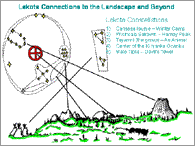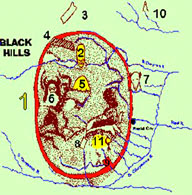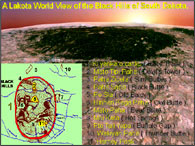According to Oral traditions, the Lakota people are descendents from ancient people who have always lived in the Black Hills (He Sápa) and area since the beginning of time. Lakota stories have been passed down through generations from one storyteller to another. The stories tell how our people came to be. The historical Lakota places in these stories are of the oldest natural geographic features on the face of Mother Earth.
Our Lakota Ancestors called the Black Hills (He Sápa); Wamaka Og'naka Icante, which means, "the heart of everything that is" and believe it is the center of their universe. Now it has been verified not only by school educated researchers, as it is said in the book, Lakota Star Knowledge, but by modern science, through such data as satellite images. The satelite images have shown the Black Hills as the shape of the human heart.
In the creation stories by the Lakota ancestors, they say they emerged from beneath the earth, out of Wind Cave, now a national park. Around the Black Hills (He Sápa) is a Sacred Hoop (Chan Gleshka Wakan), or also called the red race track (Ki Inyanka Ocanku). In the circle and in the Black Hills (He Sápa) are places of importances, (historical places) and meeting areas. Some of these are Harney Peak, Pe Sla, Ghost Butte and Thunder Butte. Other places of importances and historical sites include Devil's Tower (MaTó Tipila), Bear Butte(MaTó Páha), the Badlands (makóSica), Wounded Knee (Cankpé Opi, Kaga) , Buffalo Gap (Mato Tipula), and Slim Buttes(Paha Zipela).
For our Lakota Ancestors and for the Lakota people today, they believe, all of Mother Earth (MaKá Iná) and all of Creation is sacred and should be treated as such; offerings, asking permission, giving thanks and honoring.
The book Lakota Star Knowledge, discusses four Lakota constellations which our Lakota Ancestors observed. They believed the Black Hills is a mirror to these constellations. As the sun moved counterclockwise through the four Lakota constellations through so did our ancestors. These constellations that told the Lakota what ceremonies to do and where to do them.
When the sun is in the Lakota constellation of Casasa Ipusye, Dried Willow the people prepare for the pipe ceremony to celebrate the first day of spring.
Then the sun moves into the Lakota constellation Wicincala Sakowin, Seven Little Sisters. They go to Harney Peak (Hinhan Kaga Paha) to celebrate "welcoming back the thunders"(Yate Iwakicipi).
When the sun moved to the Lakota constellation Ki inyanka Ocanka-Race Track aka Can Gleska Wakan-The Sacred Hoop, the people go to the center of the Black Hills preparing to welcome back all life in peace.
Finally the sun is in the Lakota constellation Mato Tipila-The Bear's Lodge aka Devil's Tower the people are at Mato Tipila Paha- Devil's Tower to celebrate Summer Solstice with the Sun Dance. Goodman uses knowledge of constellations along with Lakota oral tradition to suggest that the earliest spring journeys of the Lakota might have occurred 2000 - 3000 years ago.
Oglala Lakota
This map was created sometime between 1880 and 1913 by Amos Bad Heart Bull, (1869-1913). This is a pictographic history of the Lakota people based on information provided by his Elders. It depicts the Black Hills and it represents eight sacred places, all within the confines of a red clay or racetrack, that encircles the Black Hills. One site included within the racetrack, but is not physically within it is Devil's Tower (Mato Tipila), it is outside of the Racetrack by nearly sixty miles.
The Numbers refer to Places of Importances
1. Race Track Valley - Sacred Hoop, Chan Gleshka Wakan, or the red race track, Ki Inyanka Ocanku
2. Devil's Tower (WY) - MaTó Tipila
3. Slim Buttes - Paha Zipela, - The Slim Buttes was a particularly important hunting and food-gathering area for the Sioux
4. Black Butte - Paha Sapa
5. Old Baldy - Pe Sla
6. Ghost (Owl) Butte - Hinhan Kaga Paha
7. Bear Butte - Mato paha
8. Hot springs - Mnikata
9. Buffalo Gap - Pte tali yapa - Sacred entrance/exit to Hoop or Race Track.
10. Thunder Butte - Wakinyan Paha
11. Harney Peak- Hinhan Kaga
"Why it called a Racetrack?"
Places of Importances-, Sacred Sites: Badlands (MakóSica), Wounded Knee (Cankpé Opi, Kaga) and - Stronghold Table (Oyaspe Wasake). For our Lakota Ancestors and for us, the Lakota people, our way of life changed after contact with the Euro-Americans to this area. These did not understand our tribal people and our relationship with the land. As more and more non natives came it started to challenge the survival of Lakota Culture and the people.
For thousands of years, the Lakota People existed in harmony with the land. After gold was discovered, it became more and more difficult for our ancestors to continue to hunt and travel as Lakota people had always done. The US Government brought large numbers of soldiers and settlers to this region and built many fortifications, eventually gaining control over the land. During this time there was almost continuous fighting, as the Lakota people were threatened and many on both sides of the conflict died.
The dominant Euro - Americans did not understand and didn't want to understand our ancestors relationship with the land and how they lived. They began clearing the land, building homes and farms, fencing and bringing strange diseased animals. This made it difficult for our people to continue to hunt, fish, and travel as we had done for thousands of years. Although many treaties were signed , In 1868 the Fort Larmie Treaty was signed, which set aside the Black Hills (He Sápa) and surrounding area for the Lakota people.
However, in 1864, General George Armstrong Custer's expedition discovered gold in the Black Hills and the US government broke its treaties with the Lakota people. The Soldiers were forcing the Lakota tribes, and all native tribes on to Indian reservations. Of course our ancestors resisted and even tried to fight for their lands under the leadership of Sitting Bull and Crazy Horse. Most well known fight was General Custer's attack on Lakota and Cheyenne tribes while they camped at the Greasy Grass, what is now know as Battle of Little Big Horn. Although the battle was won, the war was lost and sadly the Lakota people were defeated, mainly because the slaughter of the buffalo.
Hence the arrival of the Ghost Dance in 1890, bringing hope to the Lakota People. They believed this dance would bring back the dead and the buffalo, as well as eliminate the Euro-Americans. The US Army try to put a stop to the Ghost Dance and there were many battles. One of the battles claimed the life of Sitting Bull and caused the band of Sitting Bull to leave their reservation in fear. They met up with Big Foot and his tribe and they all decided to go to Pine Ridge where they thought they would be safe.
When the Lakota people reached the Badlands, they were taken captive by soldiers and moved to a Wounded Knee. With their weapons taken, they were starving, sick and cold when they were attacked by drunk soldiers and massacred. It was the one of last massacre and bloody confrontation brought on by US Army on the Lakota People. Survivors and frighten Lakota people ran into the badlands, specifically to the Stronghold, where they made a stand to protect themselves from the same soldiers who had just murdered over 200 men, women, and children at Wounded Knee. Today, memorial marker are at the site of the "Wounded Knee Massacre", and descendants of the survivors still live on nearby reservations. This is why the badlands and wounded knee are places of importance to the Lakota people.
Here it is almost almost 140 years later, and the Lakota people remain in the fight for the return of their Sacred Hills. Today many Lakota people still will assert, "The Black Hills is the home of our heart, and the heart of our home". Rick Two-Dogs, a Lakota medicine man, summed up the attitude of his people toward the Black Hills:
"All of our origin stories go back to this place. We have a spiritual connection to the Black Hills that can't be sold. I don't think I could face the Creator with an open heart if I ever took money for it."
References and Credits
Lapointe, J 1976. Legends of the Lakota Indian
Historian Press, San Francisco, CA.
"http://www.sdsmt.edu", satelite image
Sinte Gleska University, Lakota Star Knowledge, Rosebud Sioux Reservation, N.D.
"A Broken Treaty Haunts the Black Hills." Sioux Falls, SD, ArgusLeader. 2003.
http://stronghold.table.tripod.com/ George Tall - Tokala Fund c/o Lakota Land Alliance P.O. Box 460 Manderson, South Dakota 57756
From historical documents and are believed to be in the public domain


